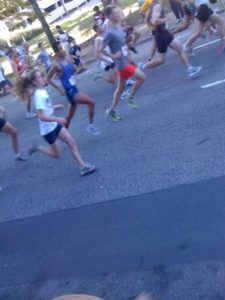 I wrote the following article for the Charlotte Observer and The News & Observer in Raleigh; it appeared in both papers on May 15. It appears here in expanded form, with links.
I wrote the following article for the Charlotte Observer and The News & Observer in Raleigh; it appeared in both papers on May 15. It appears here in expanded form, with links.
OK, time for your daily workout. Put on the sweats, lace up the sneakers and now to get limbered up with some long, deep stretches … .
Not so fast there, Jane Fonda.
It wasn’t long ago that most people began their workouts – be it an aerobics class at the gym or a 5-mile run – with a series of stretches. Toe touches, lacing your fingers behind your head to stretch your upper back muscles, and other so-called “static stretches” were once considered the proper way to prepare your body for a workout.
Now, growing evidence suggests the opposite may be true, that stressing muscles before they’ve warmed up not only doesn’t help prevent injury, it can cause them.
“That puts a lot of stress on body,” says Laurie Pace, group exercise coordinator for the Morrison Family YMCA in Charlotte who began teaching 17 years ago. “You’re asking it to make immediate changes, to go from cold to hot over a few seconds.”
Pace says that thinking began to change 10 years ago when the American College of Sports Medicine advised their 45,000 certified instructors to change the way they ease into exercise programs.
Today, the experts advise, warm up first, work out and then stretch at the end.
“Now,” says Steven Wheelock, a wellness instructor with Rex Wellness Center in Knightdale, “we try to simulate what it is you’ll be doing in a workout. With the warm-up, we want to elevate your heart rate, your breathing and sweating in preparation for” rigor to come.
The new warm-up
Ten years ago before a 5K race it was common to see runners employing all sorts of glute, hamstring and calf stretches right before the gun went off. A recent study of about 3,000 runners conducted by USA Track & Field found that prerace stretching did not reduce the risk of injury.
A better approach to warming up before a run, says Pace, is to “walk in an exaggerated motion, swinging arms, bringing your knees toward your chest. This will prepare the body – your glutes, your hamstrings – for forward movement. It’s an unnatural position for running, but it starts movement process.”
In the Total Strength class Pace teaches, she says they spend the first 3 to 5 minutes simulating the exercises they’ll be doing, minus the weights. “We’ll start with a smaller range of motion, gradually building up.”
That 3- to 5-minute warm-up window, notes Wheelock, is what it takes to get your heart rate properly elevated.
Stretching still has its place as part of a workout, only at the end. After cooling down – in much the same way you warm up, by replicating the motions of your workout but with decreased exertion. And Pace says stretching help keeps your blood from pooling and creating a buildup of lactic acid.
That’s significant, she says, because it will lessen the soreness you might feel later on.
Taking the time
Getting the word out about the proper way to get into a workout is one thing. Getting people to stand still long enough to do it is another.
Shelly Tkach teaches beginner 5K and 8K running programs for Fleet Feet in Raleigh. The programs take new runners and train them to run a 5K or an 8K within 12 weeks. Before every 25- to 30-minute run she devotes 5 minutes to dynamic stretches, such as walking while bringing the knees up to the chest.
Are the newcomers embracing this aspect of the workout?
Tkach smiles. “They do it because they’re told to. Usually, they’re so hyper they just want to get out and start running.”
Stretching to improve flexibility is good, but not necessarily right before a workout. Here are some stretching guidelines from the American College of Sports Medicine:
- Do flexibility exercises at least two or three days a week to improve range of motion.
- Hold each stretch for 10-30 seconds, “to the point of tightness or slight discomfort.”
- Repeat each stretch two to four times. You want to total 60 seconds of stretching.
- Static, dynamic, ballistic and PNF — proprioceptive neuromuscular facilitation — stretches are all effective.
- Stretching exercises are most effective when the muscle is warm, following light aerobic activity, for example, or a hot bath.
Warming up for key activities
Golf
Katherine Roberts, certified golf performance coach and author of “Swing Flaws and Fitness Fixes,” recommends six dynamic moves, each held for two to five deep breaths, prior to going 18.
1. Standing pelvic tilts
2. Speed trunk rotation
3. Standing hip stretch
4. Shoulder stretch with club behind back
5. Neck stretch
6. Standing rhomboid, upper back and neck stretch
Specifics on how to do each activity here.
Basketball
From the Web site Growtall.com:
1. Low intensity aerobic activity such as jogging a few laps around the court or even jump rope. The key is low intensity.
2. Leg swings/pendulum swings.
Walking and hiking
From Prevention Minnesota:
1. Ankle circles
2, Leg swings
3. Pelvic loops
4. Arm circles
Running
From Runner’s World magazine:
1. Walk for two minutes, then jog at a conversational pace for 15 to 20 minutes to raise your heart rate.
2. Loosen and activate your muscles with five to 10 minutes of dynamic stretches and form drills such as lunges, skipping, and high-knees running.